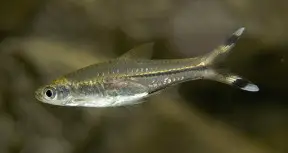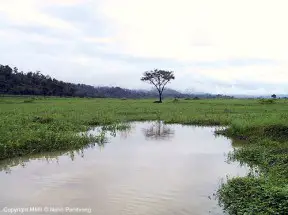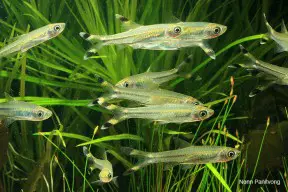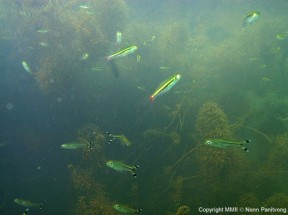Rasbora trilineata
Scissortail Rasbora
Classification
Cyprinidae
Distribution
Native to the Chao Phraya and lower Mekong river basins in Laos, Thailand and Cambodia and is widespread in Peninsular Malaysia with its distribution also extending into the Greater Sunda Islands of Sumatra and Borneo. It may be restricted to eastern Sumatra and south and western parts of Borneo including the Malaysian state of Sarawak and Indonesian province of West Kalimantan (Kalimantan Barat). At any rate specific occurences are far too many to list here. Wild caught fish are increasingly hard to come by in the hobby as it is being produced commercially in several countries.
Habitat
Clearly an adaptable fish as it has been collected various types of habitat including swiftly-flowing forest hill streams with substrates of boulders, smaller stones, sand or gravel and more sluggish blackwaters associated with areas of ancient peat swamp forest which are typically full of fallen leaves, twigs and branches. In the former the water tends to be clear with a pH between 6.5 and 7.5 whereas in the latter it is characteristically stained brown due to the release of tannins and other chemicals released by decomposing organic matter, very soft (negligible hardness) and acidic (pH 4.0 – 6.0). Such forested environments are often dimly-lit due to the tree canopy above. It also inhabits permanent bodies of water including many reservoirs and lakes and is known to move into flooded areas during the wet season across some of its range.
Maximum Standard Length
Fully-grown at around 6″/15cm which is significant as it is usually sold at a much smaller size.
Aquarium SizeTop ↑
An active species and a group will need a tank measuring at least 48″ x 18″ x 18″/120cm x 45cm x 45cm/255 litres.
Maintenance
Choice of decor is not as critical as water quality and the amount of open swimming-space provided. We suggest keeping it in a large, well-planted aquarium or alternatively it would look superb in a set-up designed to resemble a flowing river with a substrate of variably-sized rocks and gravel and some large water-worn boulders. A rivertank manifold could also be constructed to provide naturalistic unidirectional flow. The tank can be further furnished with driftwood branches and aquatic plants for aesthetic value. While the vast majority of plant species will fail to thrive in such conditions possibilities include hardy species such as Java fern, Bolbitis or Anubias species which can be grown attached to the decor.
It will also do well in a tank set up to recreate a peat swamp–type environment with dim lighting, roots and branches, leaf litter and real peat fibre added to the filter or mixed into the substrate. You could also add aquatic plant species that can survive under such conditions such as Microsorum pteropus (Java fern), Vesicularia dubyana (Java moss) and Cryptocorynes. In either situation the tank must have a very tightly-fitting cover as this species is a surface-dweller, an accomplished jumper and can escape through the tiniest of gaps. Like many other species that hail from such pristine natural environments it is intolerant to the accumulation of organic wastes and requires spotless water at all times in order to thrive.
It may be wise to ask about the origin of your fish before purchase as populations from flowing waters may require acclimatisation to more acidic, less-oxygenated conditions and vice versa. The widely-available captive-bred fish are likely to be adaptable to both sets of conditions but wild fish might be more delicate. This species also seems to react badly if introduced to the aquarium too quickly so try to acclimatise it over a couple of hours if possible.
Water Conditions
Temperature: 73 – 77°F/22 – 25°C
pH: 5.0 – 8.0 depending on the origin of the fish but somewhere between 6.5 – 7.5 usually proves ideal in the aquarium.
Hardness: 2 – 12°H
Diet
According to stomach analyses of wild specimens this species feeds mainly on invertebrates both aquatic and terrestrial, particularly insects. In the aquarium it will accept dried foods of a suitable size but should not be fed these exclusively. Daily meals of small live and frozen fare such as Daphnia, Artemia and suchlike will result in the best colouration and encourage the fish to come into breeding condition.
Behaviour and CompatibilityTop ↑
This species is very peaceful indeed making it an ideal resident of the larger, well-furnished community tank. As it places no special demands in terms of water chemistry it can be combined with many of the most popular fish in the hobby including other cyprinids as well as tetras, livebearers, rainbowfish, anabantoids, catfish and loaches. As always when selecting a compatible community of fish proper research is essential and its adult size must be a consideration. A community based around one of its native countries or river basins would also make a worthwhile project with some interesting alternatives. For example in the Endau river drainage, Peninsular Malaysia sympatric species include Barbonymus schwanenfeldii, Crossocheilus oblongus, C. langei, Mystacoleucus marginatus, Puntius lateristriga, P. banksi, P. johorensis plus various members of Rasbora, Cyclocheilichthys, Pangio, Homaloptera and Nemachelius.
It is a gregarious species by nature and really should be kept in a group of at least six to get the best out of it in the aquarium. The fish show better colours in the presence of conspecifics, are less nervous and the display on the whole is far more natural-looking.
Sexual Dimorphism
Mature females are noticeably rounder-bellied and often a little larger than males.
Reproduction
This is one of the easier members of the genus to breed and like most cyprinids is an egg-scattering, continuous spawner that exhibits no parental care. That is to say when the fish are in good condition they will spawn often and in a densely-planted, mature aquarium it is possible that small numbers of fry may start to appear without human intervention.
However if you want to increase the yield of fry a slightly more controlled approach is required. The adult group can still be conditioned together but one or more long, shallow, say 48″ x 12″ x 12″/120cm x 30cm x 30cm/113 litre containers should also be set up and half-filled with water. These should be very dimly lit and the base covered with some kind of mesh of a large enough grade so that the eggs can fall through it but small enough so that the adults cannot reach them. The widely available plastic ‘grass’-type matting can also be used and works very well for other species. The water itself should be of slightly acidic to neutral pH with a temperature towards the upper end of the range suggested above. An internal power filter can be added initially and this should be positioned so that the flow is directed down the full length of the tank.
When the adult fish are well-conditioned and the females appear full of eggs one or two pairs should then be introduced to each container. Spawning can be initiated by adding small amounts of cool water every few hours in such a way that the tank is gradually topped up and feeding small amounts of live and frozen foods. Several spawning events will probably occur before a female is spent of eggs.
The adults will likely eat any eggs they find and are best removed after a couple of days at which point the power filter should be switched for a mature sponge-type unit in order to avoid fry being sucked into the mechanism. Incubation in Rasbora eggs is temperature-dependant to an extent but usually takes between 18 and 48 hours with the young free-swimming 24 to 48 hours later. Initial food should be Artemia nauplii and/or microworm.
NotesTop ↑
This popular species is also known as the ‘three-lined’ rasbora and provided a large enough tank is available it is an excellent choice for those new to the hobby. The ‘scissortail’ moniker is derived from the characteristic twitching motion of the caudal fin when the fish is at rest. It can be distinguished from the similar R. caudimaculata by lacking red colouration in the caudal fin and from R. spilocerca by its much larger size. Several geographical forms appear to exist as some wild populations exhibit varying degrees of yellow pigmentation in the caudal fin.
Rainboth’s ‘Fishes of the Cambodian Mekong’ characterised members of Rasbora by possession of an unbranched, non-spiny first dorsal fin ray and seven soft dorsal rays, origin of the dorsal fin in the middle of the body, five branched anal fin rays, a small mouth not extending below the eye and a lack of barbels. It’s long been recognised as a polyphyletic lineage as noted by Kottelat (1999) amongst others, and in 2010 the results of a phylogenetic analysis by T. Y. Liao et al. suggested a number of changes in order to improve the taxonomy. The authors found species of rasborin genera to actually represent a monophyletic grouping existing in six clades and erected four new genera (all containing former members of Rasbora) in order to preserve monophyly of the existing groups i.e. Boraras, Horadandia, Rasbora, Rasboroides and Trigonostigma.
According to the authors the first two clades are monotypic; R. brittani should now be referred to as Kottelatia brittani and R. dorsiocellata as Brevibora dorsiocellata. The third clade comprises Boraras brigittae, Horadandia atukorali, Rasboroides vaterifloris, Trigonostigma heteromorpha and three species previously included in Rasbora but also moved into new genera; Trigonopoma gracile, T. pauciperforatum and Rasbosoma spilocerca. The results for B. brigittae and T. heteromorpha were found to be inconclusive in some respects and further work regarding their phylogenetic position was recommended.
The fourth clade includes Rasbora semilineata, R. borapetensis, R. rubrodorsalis and an undescribed fish similar to R. beauforti. Clade five consists of R. daniconius, R. hubbsi, R. paucisqualis, R. wilpita, R. kobonensis, R. ornata and R. cf. daniconius. Clade six, meanwhile, is subdivided into two groupings. The first contains R. einthovenii, R. elegans and R. cephalotaenia and the second R. lateristriata, R. argyrotaenia, R. volzii, R. paviana, R. rasbora (plus an undescribed, similar fish), R. caudimaculata and R. trilineata. As this final clade contains the type species (see below) its members retain the generic name Rasbora as do clade five species because they don’t differ sufficiently to warrant a the erection of a new genus/genera.
Unfortunately many species weren’t included in the analysis, meaning inevitable questions are raised regarding the correct placement of the 40 or so other Rasboras, in particular. As the genus had previously been split into various ‘species groups’ (groups of closely-related species) dating back to Brittan (1972, who referred to them as ‘species complexes’) Liao et al. proposed the following arrangement whilst noting it may be subject to change with further phylogenetic studies:
R. semilineata species group: R. semilineata, R. borapetensis, R. rubrodorsalis.
R. trifasciata species group: R. trifasciata, R. amplistriga, R. api, R. bankanensis, R. dies, R. ennealepis, R. hubbsi, R. johannae, R. kluetensis, R. meinkeni, R. nodulosa, R. paucisqualis, R. rutteni, R. sarawakensis, R. taytayensis, R. tobana, R. truncata, R. tuberculata.
R. daniconius species group: R. daniconius, R. armitagei, R. dandia, R. kobonensis, R. labiosa, R. microcephalus, R. ornata, R. wilpita.
R. einthovenii species group: R. einthovenii, R. cephalotaenia, R. elegans, R. jacobsoni, R. kalochroma, R. kottelati, R. nematotaenia, R. patrickyapi, R. tubbi.
R. argyrotaenia species group: R. argyrotaenia, R. aprotaenia, R. aurotaenia, R. baliensis, R. borneensis, R. bunguranensis, R. dusonensis, R. evereti, R. hobelmani, R. hossi, R. lateristriata, R. laticlavia, R. leptosoma, R. philippina, R. septentrionalis, R. spilotaenia, R. steineri, R. tawarensis, R. tornieri, R. volzii.
R. sumatrana species group: R. sumatrana, R. atridorsalis, R. calliura, R. caudimaculata, R. dorsinotata, R. notura, R. paviana, R. rasbora, R. subtilis, R. trilineata, R. vulgaris.
Not classified: R. beauforti, R. chrysotaenia, R. gerlachi (validity in question), R. lacrimula (said to compare most closely with R. dies and R. semilineata which are members of the R. trifasciata and R. semilineata groups, respectively) R. kalbarensis, R. reticulata, R. vulcanus (possibly not Rasboras) and R. zanzibarensis (identity in question).
NB – this list has been amended from that published in Liao et al. to reflect subsequent new species descriptions and taxonomical changes.
Shortly afterwards a paper investigating systematics of the subfamily Danioninae was published by Tang et al. (2010) Their results differed wildly from those of Liao et al. and the four new genera plus Boraras and Trigonostigma were synonymised with Rasbora based on an incomplete knowledge of relationships within the group, an approach they describe as ‘more conservative’. Though perhaps neither conclusion is satisfactory we decided to adopt the system of Liao et al. pending future studies, if only because we prefer to retain Boraras and Trigonostigma.
The identity of the type species, often given as R. rasbora in the past, is no longer in question; when Bleeker first referred to the name Rasbora in 1859 only four nominal members were included of which R. cephalotaenia (known as Leuciscus cephalotaenia at the time) should be considered the type. Howes (1980) suggested the separation of a number of species into the new genus Parluciosoma with type species P. (Rasbora) argyrotaenia but the monophyly of that grouping was not recovered by Liao et al..





